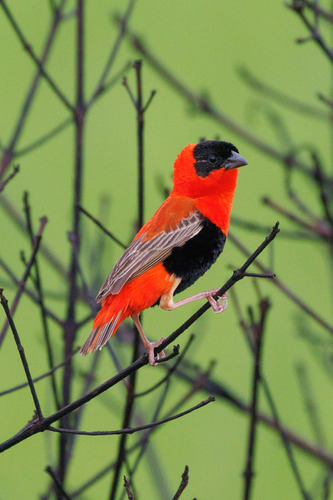
Northern Red Bishop
The Northern Red Bishop (*Euplectes franciscanus*) is a striking and vibrant bird species belonging to the weaver family. Known for the male's brilliant red and black breeding plumage, it plays a significant role in the ecosystems it inhabits, primarily as a seed disperser. Originally native to sub-Saharan Africa, it has been introduced to other parts of the world, sometimes becoming established as an invasive species. While not globally threatened, localized population declines have been observed in some areas due to habitat loss and the cage-bird trade.
10-11 cm
Length
15-17 cm
Wingspan
Least Concern
Conservation Status
Distribution
Native to sub-Saharan Africa, ranging from Senegal east to Ethiopia and south to Angola and Zambia. Introduced populations exist in the West Indies (Puerto Rico, Martinique, Guadeloupe), the United States (California, Texas), and Japan.
Lifespan
Typically 2-5 years in the wild; up to 10 years in captivity.
Northern Red Bishop's Habitat
Habitat Types
Grasslands, Savannas, Wetlands (especially reedbeds), Cultivated areas (rice paddies, sugarcane fields)
Climate Zones
Tropical, Subtropical
Adaptations
The Northern Red Bishop's strong beak is well-suited for cracking seeds, a primary food source. Its preference for grasslands and wetlands reflects its dependence on these habitats for both food and nesting materials.
Variations
No formally recognized subspecies, but slight variations in plumage intensity and size may occur across its extensive range.
Appearance
Breeding Plumage
Breeding males have bright red upperparts, head, and breast, with a black belly, face mask, and wings. Non-breeding males and females are dull brownish-yellow with streaked upperparts and paler underparts.
Seasonal Feather Changes
Males molt into their vibrant breeding plumage during the breeding season and revert to a duller, female-like plumage outside of this period.
Sex Based Plumage Differences
Highly pronounced sexual dimorphism during the breeding season. Males are brightly colored, while females remain cryptically colored year-round.
Notable Features
Bright red breeding plumage in males., Conical, seed-cracking bill., Short, rounded wings.
Diet and Feeding
Primary Foods
Seeds (grasses, weeds), Insects (especially during breeding season), Small grains (rice, millet)
Foraging Behavior
Forages on the ground in flocks, often near water. They glean seeds from plants and the ground and may occasionally hawk insects in the air.
Specializations
Their strong, conical bill is specialized for cracking seeds efficiently.
Seasonal Diet Variations
Diet shifts to include more insects during the breeding season to provide protein for growing chicks. Outside of the breeding season, seeds form the bulk of their diet.
Behavior
Social Structure
Highly gregarious outside of the breeding season, forming large flocks. During the breeding season, males become territorial and polygynous, defending small territories containing multiple nests.
Communication
Variety of chirps and whistles., Males have a buzzing song used in territorial displays., Visual displays, including fluffing of plumage.
Migration
Generally non-migratory, but may undertake local movements in response to food availability or rainfall.
Territorial or Group Behaviors
Breeding males are highly territorial, defending their nesting areas from other males. Outside of the breeding season, they form large, non-territorial flocks.
Conservation
Threats
Habitat loss (conversion of grasslands to agriculture), Trapping for the cage-bird trade (in some regions), Pesticide use (affecting insect prey)
Protection Programs
None specifically targeted at this species, but general habitat conservation efforts benefit it.
Local National Laws
Protected under general bird protection laws in many countries. Regulations on trapping and trade may exist in some areas.
Population Trend
Stable
Population Estimates
Widespread and abundant; global population not quantified but estimated to be in the millions.
Interesting Facts
Males build multiple nests within their territories.
This allows females to choose the most suitable nest for laying their eggs.
They are considered pests in some rice-growing regions.
Large flocks can cause damage to rice crops.
Introduced populations have become established in several areas outside their native range.
This demonstrates their adaptability to new environments.
Faqs about Northern Red Bishop
What is the difference between a male and female Northern Red Bishop?
Breeding males are bright red and black, while females and non-breeding males are dull brownish-yellow and streaked.
Where can I see a Northern Red Bishop?
In sub-Saharan Africa within their native range, or in areas where they have been introduced, such as parts of the West Indies, the United States, and Japan. Look for them in grasslands, wetlands, and cultivated areas.
Are Northern Red Bishops endangered?
No, they are classified as Least Concern by the IUCN, meaning they are widespread and abundant.
Copyright @ Nature Style Limited. All Rights Reserved.
 English
English